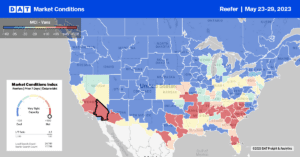Understanding the demand for produce is critical to understanding supply and demand, and a great place to start is your local festival. Most produce-growing regions love to celebrate their annual harvest and typically hold a significant festival each year around the peak harvest time. Here are some key dates to watch:
- Florida Strawberry Festival – March 2-12 – Plant City, FL.
- Vidalia Onion Festival – April 20-23 – Vidalia, GA.
- Georgia Strawberry Festival – April 15 – Musella, GA.
- Skagit Valley Tulip Festival – April 1-30 – Western Washington State.
- California Strawberry Festival – May – Oxnard, CA
- Tulip Time – May 6-14 – Holland, Michigan
- Georgia Peach Festival – June 2-3 – Fort Valley, GA.
- Blueberry Festival – June 25 – Hammonton, NJ.
- Walla Walla Annual Sweet Onion Festival – Washington State – mid to late July
- Idaho Spud Day – September – Shelley, ID
- San Luis Valley Potato Festival – September – Monte Vista, CO
- National Blueberry Festival – August 10-13 – South Haven, MI
- National Apple Harvest Festival – October 7-8 & 14-15 – Gettysburg, PA
- Apple Blossom Festival – April 27 – May 7 – Wenatchee, WA
- Artichoke Festival – June 10-11 – Monterey, CA
- SXSW – Avocados from Mexico and other Produce Industries – March 12-15 – Austin, TX
- California Avocado Festival – October 7-8 – Carpinteria, CA
- Palisade Peach Festival – August 18-19 – Palisade, CO
- California Garlic Festival – August 5-6 – Stockton, CA
- Upland Lemon Festival – June 9-11- Upland, CA
- Cloverdale Citrus Festival – February 17-20 – Cloverdale, CA
- South Carolina Strawberry Festival – May 6 – Fort Mill, SC
- Cullman Strawberry Festival – May 6 – Cullman, AL
- Ham and Yam Festival – May 6 – Smithfield, NC
- West Tennessee Strawberry Festival – May 7-13 – Humboldt, TN
- Tennessee Strawberry Festival – May 8-13 – Dayton, TN
- Pasadena Strawberry Festival – May 18-21 – Pasadena, TX
- California Strawberry Festival – May 20-21 – Ventura, CA
- Lebanon Strawberry Festival – June 1-4 – Lebanon, OR
- Georgia Blueberry Festival – June 2-3 – Alma, GA
- Louisiana Peach Festival – June 3 – Ruston, LA
- National Asparagus Festival – June 10 – Hart, MI
- North Carolina Blueberry Festival – June 16-17- Burgaw, NC
- National Cherry Festival – July 1-8 – Traverse City, MI
- State Fair of Texas – September 29- October 22 – Dallas, TX
- Minnesota State Fair – August 24-September 4 – St Paul, MN
- New York State Fair – August 24-September 4 – Syracuse, NY
- Iowa State Fair – August 10-20 – Des Moines, IA
*More Local Festivals can be found here
Market Watch
All rates cited below exclude fuel surcharges unless otherwise noted.
Outbound linehaul rates in California cooled slightly last week, decreasing by $0.04/mile to $2.40/mile, identical to 2020. After increasing for the prior three weeks, outbound linehaul rates in Fresno decreased by $0.02/mile last week to an average of $2.17/mile, which is almost the same amount carriers were being paid for long-haul loads to Hunts Point, NY, and also the highest in 12 months. Outbound reefer rates dropped by $0.05/mile to $2.11/mile in the San Francisco market, including the Salinas Valley produce region. There was solid demand for loads from Salinas to Calgary, AB, where spot rates at $2.58/mile were $0.30/mile higher than the April average but $1.70/mile lower than the previous year.
At $2.52/mile, loads from Miami to Montreal have almost tripled since last November but are still around $0.50/mile lower than the previous year. Outbound reefer rates in Florida continue to cool and, at $2.30/mile, are down $0.01/mile w/w after increasing by almost $1.00/mile since April. Further west in Laredo, TX, reefer capacity was very tight last week; spot rates jumped by $0.15/mile to $2.28/mile on a 17% lower volume. Laredo to Dallas loads were paying $3.22/mile, $0.20/mile lower than last year, while loads further east to Atlanta were $0.10/mile higher than the April average at $2.47/mile, which was around $0.15/mile lower than the previous year.
Outbound capacity was also tight in Atlanta last week, where linehaul rates increased by $0.11/mile to $2.18/mile, making it four weeks of gains. On the high-volume lane south to Lakeland, FL, linehaul rates ended last week at $2.48/mile, which was $0.04/mile higher than the April average. Atlanta to Miami loads were paying $2.25/mile, up $0.20/mile on the April average but around $0.30/mile lower than the previous year.

Load to Truck Ratio (LTR)
Following the prior week’s volume surge leading to the Memorial Day long weekend, volumes retreated last week, dropping by 21%. According to the USDA, national produce volumes are still around 14% lower than last year, impacting overall reefer spot market volumes. After reporting a slight shortage of trucks in the six produce-growing regions in California in the first two weeks of May, capacity has loosened, with an adequate supply reported last week. Equipment posts were 5% higher last week, resulting in the reefer load-to-truck (LTR) decreasing from 5.25 to 3.93.
Spot Rates
Reefer linehaul rates were flat last week, maintaining the gains from the prior week’s surge in spot rates. At $2.05/mile, reefer spot rates are just $0.02/mile higher than in 2019. Compared to the same time the previous year, spot rates are $0.31/mile lower than the last year and around $0.23/mile behind where they were in 2018 and above 2019 by the same amount.


